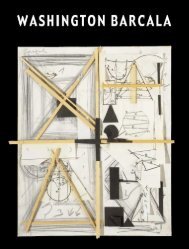Jameos del Agua - Fundación César Manrique
Jameos del Agua - Fundación César Manrique
Jameos del Agua - Fundación César Manrique
Sie wollen auch ein ePaper? Erhöhen Sie die Reichweite Ihrer Titel.
YUMPU macht aus Druck-PDFs automatisch weboptimierte ePaper, die Google liebt.
ser un valle de ceniza, sino que su<br />
morfología está dominada por la<br />
construcción regular de los socos,<br />
esos muretes semicirculares<br />
levantados por los campesinos para<br />
defender los cultivos de sus viñas de<br />
los vientos dominantes.<br />
Justo cuando <strong>Manrique</strong> se instala<br />
en Nueva York, en diciembre de<br />
1964, en el MoMA (Museo de Arte<br />
Moderno) se está exhibiendo una<br />
exposición titulada Arquitectura sin<br />
arquitectos, en la que se muestran<br />
fotografías de construcciones rurales<br />
de todo el mundo que explican cómo<br />
las limitaciones de los materiales y la<br />
necesidad han mo<strong>del</strong>ado unas formas<br />
económicas, funcionales y plásticas,<br />
tan expresivas como sorprendentes.<br />
Sin duda, tanto esta exposición como<br />
otras experiencias vividas en Nueva<br />
York van a tener una influencia<br />
posterior en la obra no pictórica de<br />
<strong>Manrique</strong>. Por ejemplo, la<br />
comparación entre las formas <strong>del</strong><br />
prismático edificio Seagram, que<br />
Mies van der Rohe construyó en<br />
Nueva York entre los años 1954 y<br />
1958, y los desnudos volúmenes<br />
minimalistas de algunas casas<br />
terreras de Yaiza, Tinajo o Los Valles<br />
place such as La Geria is not<br />
determined only by the fact that it<br />
is a valley of ash, but that its<br />
morphology is governed by the<br />
regularity of the “socos”, low,<br />
semi-circular walls built by farmers<br />
to defend their grapevines from the<br />
prevailing winds.<br />
Just as <strong>Manrique</strong> was locating<br />
in New York, in December 1964,<br />
the MoMA (Museum of Modern Art)<br />
was showing an exhibition titled<br />
Architecture without architects,<br />
consisting in a series of<br />
photographs of rural constructs<br />
from all around the world that<br />
illustrated how material<br />
constraints and need had mo<strong>del</strong>led<br />
cost-effective, functional and<br />
plastic forms, as expressive as they<br />
were surprising. Both this<br />
exhibition and other aspects of his<br />
New York experience would<br />
indisputably have an impact on<br />
<strong>Manrique</strong>’s subsequent nonpictorial<br />
work. One example can<br />
be found in the comparison<br />
between the forms of the prismatic<br />
Seagram’s building that Mies van<br />
der Rohe built in New York<br />
between 1954 and 1958 and the<br />
105<br />
Ort wie La Geria besitzt, nicht nur<br />
daher kommt, dass es ein Tal mit Asche<br />
ist, sondern dass seine Morphologie von<br />
der regelmäßigen Struktur der<br />
halbrunden, von den Bauern<br />
aufgebauten, „Socos“ genannten<br />
Mauern, die die Weinstöcke vor dem<br />
starken Wind schützen, geprägt ist.<br />
Just als <strong>Manrique</strong> im Dezember 1964<br />
in New York ansässig wurde,<br />
beherbergte das MoMA (Museum<br />
Moderner Kunst) eine Ausstellung mit<br />
dem Titel Architektur ohne<br />
Architekten, in der Fotografien von<br />
bäuerlichen Konstruktionen aus der<br />
ganzen Welt gezeigt wurden. Diese<br />
sollten illustrieren, wie die<br />
Begrenztheit der Materialien und die<br />
Notwendigkeit zu wirtschaftlichen,<br />
funktionellen und plastischen Formen<br />
geführt haben, die sowohl<br />
ausdrucksstark als auch überraschend<br />
sind. Zweifellos hatten diese<br />
Ausstellung und auch andere in New<br />
York gemachte Erfahrungen Einfluss<br />
auf das spätere, nicht malerische Werk<br />
<strong>Manrique</strong>s. Beispiele sind im Vergleich<br />
zwischen den Formen des<br />
prismatischen Seagram-Turms zu<br />
finden, den Mies van der Rohe<br />
zwischen 1954 und 1958 in New York















![Becas y premios de la Fundación César Manrique [1997-2006]](https://img.yumpu.com/20766851/1/184x260/becas-y-premios-de-la-fundacion-cesar-manrique-1997-2006.jpg?quality=85)
